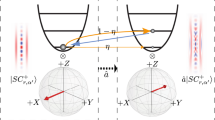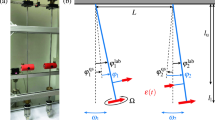Abstract
Quantum bits (qubits) are prone to several types of error as the result of uncontrolled interactions with their environment. Common strategies to correct these errors are based on architectures of qubits involving daunting hardware overheads1. One possible solution is to build qubits that are inherently protected against certain types of error, so the overhead required to correct the remaining errors is greatly reduced2,3,4,5,6,7. However, this strategy relies on one condition: any quantum manipulations of the qubit must not break the protection that has been so carefully engineered5,8. A type of qubit known as a cat qubit is encoded in the manifold of metastable states of a quantum dynamical system, and thereby acquires continuous and autonomous protection against bit-flips. Here, in a superconducting-circuit experiment, we implemented a cat qubit with bit-flip times exceeding 10 s. This is an improvement of four orders of magnitude over previously published cat-qubit implementations. We prepared and imaged quantum superposition states, and measured phase-flip times greater than 490 ns. Most importantly, we controlled the phase of these quantum superpositions without breaking the bit-flip protection. This experiment demonstrates the compatibility of quantum control and inherent bit-flip protection at an unprecedented level, showing the viability of these dynamical qubits for future quantum technologies.
This is a preview of subscription content, access via your institution
Access options
Access Nature and 54 other Nature Portfolio journals
Get Nature+, our best-value online-access subscription
$29.99 / 30 days
cancel any time
Subscribe to this journal
Receive 51 print issues and online access
$199.00 per year
only $3.90 per issue
Buy this article
- Purchase on Springer Link
- Instant access to full article PDF
Prices may be subject to local taxes which are calculated during checkout




Similar content being viewed by others
Data availability
The data that support the findings of this work are available from the corresponding author upon reasonable request.
Code availability
The code used for data acquisition, analysis and visualization is available from the corresponding author upon reasonable request.
Change history
17 May 2024
A Correction to this paper has been published: https://doi.org/10.1038/s41586-024-07565-z
References
Google Quantum AI Suppressing quantum errors by scaling a surface code logical qubit. Nature 614, 676–681 (2023).
Aliferis, P. & Preskill, J. Fault-tolerant quantum computation against biased noise. Phys. Rev. A 78, 052331 (2008).
Webster, P., Bartlett, S. D. & Poulin, D. Reducing the overhead for quantum computation when noise is biased. Phys. Rev. A 92, 062309 (2015).
Tuckett, D. K., Bartlett, S. D. & Flammia, S. T. Ultrahigh error threshold for surface codes with biased noise. Phys. Rev. Lett. 120, 050505 (2018).
Guillaud, J. & Mirrahimi, M. Repetition cat qubits for fault-tolerant quantum computation. Phys. Rev. X 9, 041053 (2019).
Darmawan, A. S., Brown, B. J., Grimsmo, A. L., Tuckett, D. K. & Puri, S. Practical quantum error correction with the XZZX code and Kerr-cat qubits. PRX Quantum 2, 030345 (2021).
Ruiz, D., Guillaud, J., Leverrier, A., Mirrahimi, M. & Vuillot, C. LDPC-cat codes for low-overhead quantum computing in 2D. Preprint at https://arxiv.org/abs/2401.09541 (2024).
Puri, S. et al. Bias-preserving gates with stabilized cat qubits. Sci. Adv. 6, eaay5901 (2020).
Guckenheimer, J. & Holmes, P. in Nonlinear Oscillations, Dynamical Systems, and Bifurcations of Vector Fields 1–65 (Springer, 1983).
Muppalla, P. R. et al. Bistability in a mesoscopic Josephson junction array resonator. Phys. Rev. B 97, 024518 (2018).
Mabuchi, H. Nonlinear interferometry approach to photonic sequential logic. Appl. Phys. Lett. 99, 153103 (2011).
Nielsen, M. A. & Chuang, I. L. Quantum Computation and Quantum Information: 10th Anniversary Edition (Cambridge Univ. Press, 2010).
Chamberland, C. et al. Building a fault-tolerant quantum computer using concatenated cat codes. PRX Quantum 3, 010329 (2022).
Fowler, A. G., Mariantoni, M., Martinis, J. M. & Cleland, A. N. Surface codes: towards practical large-scale quantum computation. Phys. Rev. A 86, 032324 (2012).
Zurek, W. H. Decoherence, einselection, and the quantum origins of the classical. Rev. Mod. Phys. 75, 715–775 (2003).
Wolinsky, M. & Carmichael, H. J. Quantum noise in the parametric oscillator: from squeezed states to coherent-state superpositions. Phys. Rev. Lett. 60, 1836–1839 (1988).
Leghtas, Z. et al. Confining the state of light to a quantum manifold by engineered two-photon loss. Science 347, 853–857 (2015).
Mirrahimi, M. et al. Dynamically protected cat-qubits: a new paradigm for universal quantum computation. New J. Phys. 16, 045014 (2014).
Lescanne, R. et al. Exponential suppression of bit-flips in a qubit encoded in an oscillator. Nat. Phys. 16, 509–513 (2020).
Grimm, A. et al. Stabilization and operation of a Kerr-cat qubit. Nature 584, 205–209 (2020).
Frattini, N. E. et al. The squeezed Kerr oscillator: spectral kissing and phase-flip robustness. Preprint at https://arxiv.org/abs/2209.03934 (2022).
Berdou, C. et al. One hundred second bit-flip time in a two-photon dissipative oscillator. PRX Quantum 4, 020350 (2023).
Touzard, S. et al. Coherent oscillations inside a quantum manifold stabilized by dissipation. Phys. Rev. X 8, 021005 (2018).
Albert, V. V. et al. Holonomic quantum control with continuous variable systems. Phys. Rev. Lett. 116, 140502 (2016).
Haroche, S. & Raimond, J.-M. Exploring the Quantum: Atoms, Cavities, and Photons (Oxford Univ. Press, 2006).
Gottesman, D., Kitaev, A. & Preskill, J. Encoding a qubit in an oscillator. Phys. Rev. A 64, 012310 (2001).
Girvin, S. M. in Quantum Machines: Measurement and Control of Engineered Quantum Systems (eds Devoret, M. et al.) 113–256 (Oxford Univ. Press, 2014).
Place, A. P. M. et al. New material platform for superconducting transmon qubits with coherence times exceeding 0.3 milliseconds. Nat. Commun. 12, 1779 (2021).
Flurin, E. The Josephson mixer: a Swiss army knife for microwave quantum optics. Phd thesis, ENS Paris (2014).
Aspelmeyer, M., Kippenberg, T. J. & Marquardt, F. Cavity optomechanics. Rev. Mod. Phys. 86, 1391–1452 (2014).
Touzard, S. et al. Gated conditional displacement readout of superconducting qubits. Phys. Rev. Lett. 122, 080502 (2019).
Yurke, B. & Stoler, D. The dynamic generation of Schrödinger cats and their detection. Physica B+C 151, 298–301 (1988).
Kirchmair, G. et al. Observation of quantum state collapse and revival due to the single-photon Kerr effect. Nature 495, 205–209 (2013).
Gautier, R,., Mirrahimi, M. & Sarlette, A. Designing high-fidelity Zeno gates for dissipative cat qubits. PRX Quantum 4, 040316 (2023).
Gautier, R., Sarlette, A. & Mirrahimi, M. Combined dissipative and Hamiltonian confinement of cat qubits. PRX Quantum 3, 020339 (2022).
Aiello, G. et al. Quantum bath engineering of a high impedance microwave mode through quasiparticle tunneling. Nat. Commun. 13, 7146 (2022).
Marquet, A. et al. Autoparametric resonance extending the bit-flip time of a cat qubit up to 0.3 s. Preprint at https://arxiv.org/abs/2307.06761 (2024).
Eickbusch, A. et al. Fast universal control of an oscillator with weak dispersive coupling to a qubit. Nat. Phys. 18, 1464–1469 (2022).
Wang, C. et al. Towards practical quantum computers: transmon qubit with a lifetime approaching 0.5 milliseconds. npj Quantum Inf. 8, 3 (2022).
Kono, S. et al. Mechanically induced correlated errors on superconducting qubits with relaxation times exceeding 0.4 milliseconds. Preprint at https://arxiv.org/abs/2305.02591 (2023).
Acknowledgements
We thank N. Frattini for his help applying a previously published protocol24 to Wigner tomography, and the SPEC at CEA Saclay for providing nanofabrication facilities. This work was supported by the QuantERA grant QuCOS and ANR 19-QUAN-0006-04. This project has received funding from the European Research Council under the European Union’s Horizon 2020 research and innovation programme (grant agreements 851740 and 884762); grants ANR-22-PETQ-0003 and ANR-22-PETQ-0006 under the France 2030 plan; and is partly funded by the CATQUBIT Horizon Europe project (grant agreement 190110172).
Author information
Authors and Affiliations
Contributions
P.C.-I., R.L., S.J. and Z.L. conceived the experiment. U.R. and A.B. designed the chip with support from M.H. and F.R. U.R. and A.B. measured the device and analysed the data. E.A. and N.P. fabricated the chip. R.G., J.C., A.M., L.-A.S., P.R., A.S. and M.M. provided theory support. U.R., A.B. and Z.L. wrote the paper with input from all authors.
Corresponding author
Ethics declarations
Competing interests
Authors affiliated with Alice & Bob have financial interests in the company. Z.L., M.M. and P.C.-I. are shareholders of Alice & Bob. P.C.-I. is a part-time employee of Alice & Bob.
Peer review
Peer review information
Nature thanks Yvonne Gao and the other, anonymous, reviewer(s) for their contribution to the peer review of this work. Peer reviewer reports are available.
Additional information
Publisher’s note Springer Nature remains neutral with regard to jurisdictional claims in published maps and institutional affiliations.
Supplementary information
Supplementary Information
Supplementary information sections 1–8.
Rights and permissions
Springer Nature or its licensor (e.g. a society or other partner) holds exclusive rights to this article under a publishing agreement with the author(s) or other rightsholder(s); author self-archiving of the accepted manuscript version of this article is solely governed by the terms of such publishing agreement and applicable law.
About this article
Cite this article
Réglade, U., Bocquet, A., Gautier, R. et al. Quantum control of a cat qubit with bit-flip times exceeding ten seconds. Nature (2024). https://doi.org/10.1038/s41586-024-07294-3
Received:
Accepted:
Published:
DOI: https://doi.org/10.1038/s41586-024-07294-3
Comments
By submitting a comment you agree to abide by our Terms and Community Guidelines. If you find something abusive or that does not comply with our terms or guidelines please flag it as inappropriate.



